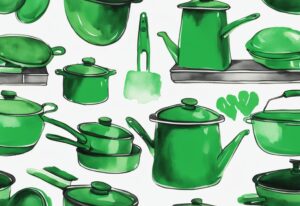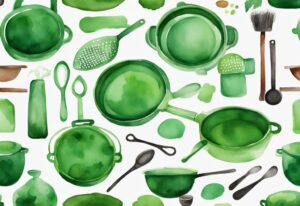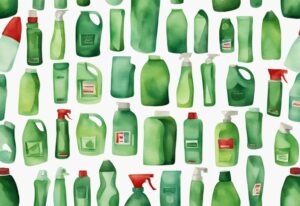Is Simple Green Non Toxic? Discover the Safe Cleaning Solution
As someone genuinely concerned about our planet, I’ve come to realize that understanding the true nature of the products we use daily is vital. Does Simple Green resonate with your pursuit of a non-toxic lifestyle? Well, you are not alone in your curiosity. I’ve often wondered, “Is Simple Green really non-toxic as it claims?”
Today, we’re taking a hard look at Simple Green, a popular cleaner that markets itself as a non-toxic alternative. We’ll scrutinize its ingredients, certifications, controversies, and listen in on what users have to say. In doing so, we’ll endeavor to clarify whether Simple Green stands true to its promise – a safe choice for us, our loved ones, and our precious planet.
Fasten your seatbelts, folks, truth-seeking can be quite the roller-coaster ride!
Understanding the Meaning of Non-Toxic
Unraveling what “non-toxic” truly means is pivotal for navigating safe product choices. This section delves into the regulatory parameters, the significance of the FTC Green Guides, and the necessity of distinguishing between “non-toxic” and other less definitive claims.
Definition of Non-Toxic According to Regulatory Standards
The term “non-toxic” implies a high level of safety, ensuring that a product poses no risk to humans, animals, or the environment under any circumstances, as outlined by the EPA’s regulatory framework for toxic substances, which gathers health, safety, and exposure data to control human and environmental exposures for numerous chemical substances and mixtures. Learn more about how the EPA regulates toxic substances. Rigorous criteria set by regulatory bodies must be met for a product to earn this label. When something is labeled as non-toxic, it means it must be safe during normal use, accidental exposure, and even misuse. This provides peace of mind, knowing that the product is inherently safe in all situations.
FTC Green Guides for “Non-Toxic” Claims
The Federal Trade Commission (FTC) Green Guides offer valuable insights into what qualifies as a non-toxic claim. According to these guidelines, a product described as non-toxic must not harm living organisms, even if used improperly. This is crucial, distinguishing products that are genuinely safe from those that could be harmful if misused. The Green Guides aim to prevent misleading marketing that could compromise consumer trust and safety.
Importance of Distinguishing Non-Toxic Claims from “Less Toxic” or “Reduced Toxicity”
Grasping the differences between “non-toxic,” “less toxic,” and “reduced toxicity” is essential. “Non-toxic” signifies zero risk and complete safety. In contrast, “less toxic” and “reduced toxicity” imply a degree of safety over other products but still carry some risk. This distinction helps in making more informed choices. For instance, when asking, “is simple green non toxic?”, it’s crucial to determine whether it meets the stringent criteria of zero harm set by regulatory standards or merely presents reduced risks.
Decoding the Non-Toxic Claims of Simple Green
Have you ever wondered about the truth behind the claims that Simple Green is non-toxic? This cleaning product has sparked a lot of debates and controversies, making it crucial for us to dive deeply into its claims and scrutinize its safety.
A Brief on Sunshine Makers, Inc. – The Company Behind Simple Green
Sunshine Makers, Inc., the minds behind Simple Green, built their reputation as champions of environmentally friendly cleaning solutions. They have a heartfelt mission: to offer cleaning products that are both safe for you and effective, while also pledging a commitment to environmental sustainability. For instance, Simple Green All-Purpose Cleaner garnered praise from the EPA Safer Choice program, a testament to their dedication to using safer chemical formulations.
Claims of False Advertising and Controversies
Is Simple Green non-toxic? This question has sparked significant legal and public scrutiny.
Invalid YouTube video ID
Imagine discovering that Sunshine Makers, Inc. had to face multiple lawsuits over the non-toxic claims found on their product labels. Due to opinions from the National Advertising Division (NAD) and the guidelines laid out by the FTC Green Guides, they decided to settle to avoid a long, expensive legal battle. As part of the settlement, they removed the non-toxic claims from their labels.
Adding another layer to the controversy, consumer advocate Michelle Moran accused Simple Green of containing harmful ingredients and misleading consumers. Terms like “greenwashing” along with assertions of violating FTC guidelines and California consumer protection laws have been thrown into the debate. These serious allegations questioned the truthfulness of Simple Green’s non-toxic branding, stirring discussions amongst consumers and environmentalists alike.
A Close Look at Simple Green’s Ingredients
Examining the Safety Data Sheets and Ingredient Disclosure
Simple Green has made reassuring strides towards consumer safety by providing comprehensive Material Safety Data Sheets (MSDS) for their products. These sheets delve into potential hazards, safe handling practices, and the ingredients used. When following the MSDS guidelines, users can confidently say that Simple Green is recognized scientifically as safe when used appropriately.
Transparency is essential to Simple Green’s philosophy, focusing on complete ingredient disclosure. This commitment goes beyond just listing ingredients; it includes educating consumers about their functions and potential effects. Such openness builds consumer trust and aligns with regulatory requirements for safety and environmental consciousness.

An example of their commitment is Simple Green’s All-Purpose Cleaner, which is recognized by the EPA Safer Choice program. This prestigious recognition is awarded to products meeting rigorous standards for human health and environmental safety, pointing to the absence of harmful chemicals and a more sustainable formula. With this in mind, discussions around “is Simple Green non-toxic” can be approached with assurance based on regulatory validation.
Digging into Potential Harmful Ingredients
Despite its non-toxic claims, Simple Green’s formula contains a variety of chemicals whose safety profiles merit consideration. Ingredients like alcohol ethoxylates, sodium carbonate, methylchloroisothiazolinone, and methylisothiazolinone have specific roles in cleaning but also present potential risks.
One noteworthy improvement was the removal of 2-butoxyethanol in 2013, a compound previously linked to health issues such as blurred vision, asphyxiation, nausea, and potential carcinogenic effects. This proactive step highlights the company’s ongoing commitment to enhancing product safety and addressing consumer health concerns.
However, ingredients like methylisothiazolinone and methylchloroisothiazolinone still present in the formula can cause skin irritation and allergic reactions in sensitive individuals. These effective preservatives have potential health impacts, such as respiratory issues and skin sensitizers. Understanding “is Simple Green non-toxic” requires considering its use and the user’s sensitivity to these compounds. For those interested in similar topics, you might also wonder, are soy candles non-toxic?
In conclusion, while Simple Green prioritizes safety and transparency, its non-toxic status is nuanced. The key takeaway is to adhere strictly to dilution instructions and handle the product as directed to mitigate any potential risks associated with its ingredient profile.
Is Simple Green Really Non-Toxic? Regulatory and Certification Insights
Simple Green’s Status with EPA Safer Choice Program
Simple Green has earned recognition from the EPA Safer Choice program, highlighting its commitment to safer chemical formulations. The EPA Safer Choice label signifies that Simple Green’s ingredients meet stringent safety criteria, aimed at protecting human health and the environment. This label underscores Simple Green’s compliance with the program’s rigorous standards, evaluating the product’s impact on both the user and the environment.
To secure the Safer Choice label, products undergo a detailed evaluation process focusing on the safety and environmental characteristics of each ingredient. This ensures formulations exclude hazardous substances. By earning this label, Simple Green reassures consumers of its dedication to safer, more effective cleaning solutions. It solidifies Simple Green’s reputation as a reliable choice for non-toxic cleaning.
How Simple Green Fares Against OECD Biodegradability Standards
When considering whether Simple Green is non-toxic, it’s crucial to look at its biodegradability. Simple Green All-Purpose Cleaner meets the criteria set by the Organisation for Economic Co-operation and Development (OECD) under the 301D standards for biodegradability. These standards assess a product’s ability to break down naturally, thereby reducing harmful environmental impacts.
Additionally, Simple Green holds a non-toxicity classification as per The Global Harmonized System of Classification and Labeling of Chemicals. This classification system aids in identifying chemicals and communicating hazards effectively, ensuring Simple Green’s formulations are safe for varied applications.
Simple Green’s compliance with both the OECD biodegradability standards and the non-toxicity classification upholds its reputation as a safe and environmentally responsible cleaner. This reassures consumers that Simple Green adheres to high safety benchmarks, emphasizing its standing as a non-toxic solution.
Expert Opinions on Simple Green’s Non-Toxicity
Simple Green’s journey towards non-toxicity is illuminated by expert evaluations and comparative data, providing a well-rounded understanding of its safety and environmental impacts.
Statements from Health and Safety Experts
Health and safety experts broadly agree that Simple Green is safe to use when following the guidelines. This consensus is rooted in the product’s formulation, which minimizes risks to health and safety. The ingredients in Simple Green are crafted to be gentle on the skin, requiring minimal special precautions such as ventilation during usage.
This assurance of safety is particularly important for households looking to avoid harsh chemicals without compromising on cleaning efficacy. While the term “non-toxic” can be contentious, experts affirm that, in practical everyday use, Simple Green aligns with these ideals by posing minimal health risks.

Comparative Toxicity Data and Environmental Safety
When assessing the overall toxicity of Simple Green in comparison to conventional cleaners, laboratory tests consistently show relatively low toxicity levels. This aligns with the product’s reputation for being safer in both household and environmental contexts.
A key advantage is the absence of EPA Priority Pollutants in its formulation, indicating a lower environmental burden compared to many traditional cleaning agents. Simple Green has also been found to be safe for diverse environments, posing no significant risks to wildlife.
These attributes underline its suitability for homes mindful of health and ecological impacts, reinforcing the claim “is simple green non-toxic” by providing a cleaner alternative to more hazardous products.
Is Simple Green Safe for Home Use?
In this section, we’ll explore how to use and store Simple Green products safely and effectively, as well as their safety around children and pets.
User Instructions for Safe Use and Storage
Simple Green products, although marketed as non-toxic, need to be used correctly to ensure safety. Over the years, I’ve discovered that following the manufacturer’s instructions for dilution is key. Not only does it enhance the cleaning power, but it also minimizes risks, such as skin irritation. Properly diluted solutions are much gentler on your skin and just as effective.
Storage is another aspect to consider carefully. Always keep Simple Green out of the reach of children and pets. This simple step can prevent accidental ingestion or exposure. I store mine in their original containers with labels intact. This way, everyone in the household knows exactly what’s inside and how to use it safely.
One valuable tip I’ve learned is to always use protective gear like gloves, especially when dealing with larger quantities or concentrated solutions. This precaution can help you avoid accidental splashes to the eyes and keep your skin safe.
Is Simple Green Safe Around Children and Pets?
When contemplating, is Simple Green non-toxic, it’s a relief to know that it’s safe for children and pets if used as directed. The absence of harsh chemicals—like ammonia, bleach, and phosphates—makes this product a go-to for households keen on safer cleaning alternatives.
Interestingly, its formulation is designed to reduce the likelihood of adverse reactions when kiddos or pets come into contact with cleaned surfaces. Still, I always make sure that surfaces are dry and free from residual cleaner before letting my pets and little ones roam free. It’s a small but crucial step to maintain their well-being while ensuring the cleaning process remains effective and safe.
User Experiences with Simple Green
Simple Green has amassed a variety of experiences from users, showcasing its strengths and areas of concern through personal stories and thoughtful reviews. Whether you’re drawn to its green credentials or have some reservations about its non-toxic claims, exploring these perspectives will help you make an informed decision.
Exploring Positive and Negative Reviews
Positive user feedback on cleaning efficacy and environmental friendliness
Many users rave about how Simple Green excels at tackling a wide assortment of cleaning tasks. From kitchen grease to patio grime, this product often goes above and beyond expectations. Its capability to handle tough stains particularly stands out. In addition to its performance, the environmentally friendly aspects of Simple Green earn consistent praise. Users love that its biodegradable formula supports a cleaner planet and appreciate the company’s commitment to reducing environmental impacts. For those seeking a greener alternative to standard chemical cleaners, Simple Green emerges as a go-to solution that resonates with eco-conscious values.
Reports of mild skin and eye irritation upon exposure to undiluted product
However, not all feedback is glowing. Some users have noted issues with skin and eye irritation when in contact with undiluted Simple Green. Instances of redness, stinging, or mild rashes have been reported, usually linked to improper dilution or lack of protective measures. It’s crucial to follow the product’s instructions carefully—diluting as directed and using gloves or goggles to avoid these issues. By respecting these guidelines, many users find they can safely enjoy the benefits of Simple Green without adverse effects.
Mixed reviews based on individual sensitivity and expectations of non-toxicity
Opinions on whether Simple Green is genuinely non-toxic vary widely. Some applaud its safety, mentioning that it doesn’t emit harmful fumes and is gentle on surfaces when used correctly. This reassures them that they’ve made a wise choice for a safer home environment. On the flip side, others feel “non-toxic” is a misnomer, especially when adverse reactions occur or if pets and children encounter the product. These mixed reviews highlight how individual expectations and sensitivities play a significant role. It’s important to weigh your own needs against the manufacturer’s safety information.
By examining these diverse user experiences, you can get a holistic view of what it means for Simple Green to be non-toxic, helping you decide if it’s the right fit for your cleaning routine.
Concluding Thoughts on Simple Green’s Non-Toxic Status
Summary of findings regarding the non-toxic claims of Simple Green:
After reviewing Simple Green’s claims and ingredients, it’s clear that “non-toxic” can be a tricky term. The EPA Safer Choice program recognizes Simple Green, spotlighting its dedication to safer chemical formulations. Transparency in ingredient disclosure and avoiding EPA Priority Pollutants emphasize efforts to reduce environmental and health impacts. However, the presence of chemicals like alcohol ethoxylates and methylisothiazolinone raises concerns, particularly when the product is undiluted or misused. Past lawsuits and claims of false advertising suggest a more complex reality—while Simple Green aims for non-toxicity, it may not meet the strictest standards under all conditions.
Balanced view on the safety and effectiveness of the product based on available data:
From a balanced perspective, Simple Green is a generally safe and effective cleaning product when used correctly. Its ability to clean without harsh chemicals like bleach and ammonia makes it appealing for safer home use. However, safety depends on proper usage and following guidelines. Laboratory tests show relatively low toxicity, supporting the product’s safety, but user experiences can vary. Positive reviews highlight effective cleaning and environmental friendliness, while reports of mild irritations underscore potential risks, especially with undiluted forms.
Importance of following user guidelines to ensure safety:
Adhering to user guidelines is crucial for ensuring the non-toxic use of Simple Green. Key practices include:
- Proper dilution: Follow instructions to dilute concentrates appropriately, reducing the risk of skin and eye irritation.
- Safe storage: Keep products out of reach of children and pets to prevent accidental exposure.
- Precautionary measures: Avoid direct eye contact and use protective gear if necessary, especially for sensitive individuals.
In conclusion, while the answer to “is Simple Green non-toxic” is yes under specified conditions, complete safety is achievable by understanding and observing recommended practices, ensuring both effective cleaning and minimal health risks. To complement your safe cleaning routine, consider using a vegan moisturizer to maintain healthy and hydrated skin.
____
Frequently Asked Questions about Simple Green
What does “non-toxic” really mean for cleaning products?
“Non-toxic” suggests that a cleaning product poses no risk to humans, animals, or the environment in any context. Regulatory standards require these products not to cause harm, even if they’re misused. For example, the FTC Green Guides mandate that “non-toxic” claims must guarantee that the product never harms any living organism.
Are there any harmful chemicals in Simple Green?
Simple Green does have some chemicals like alcohol ethoxylates, sodium carbonate, and preservatives like methylchloroisothiazolinone and methylisothiazolinone. However, the company ensures these are used within safe limits. Hazardous ingredients, like 2-butoxyethanol, were removed in 2013 to make the product safer.
Is Simple Green officially certified as non-toxic?
Simple Green is endorsed by the EPA Safer Choice program, which certifies products that meet high safety and environmental criteria. This certification acknowledges its safer formulations but doesn’t necessarily mean the product is non-toxic in all scenarios.
How can I use Simple Green safely at home?
It’s essential to dilute Simple Green concentrates as indicated on the label for safe use. Keep the product out of reach of children and pets. Follow all safety instructions, such as avoiding direct eye contact and using protective gear when necessary.
Is there any risk of using Simple Green around pets and children?
When diluted and used as directed, Simple Green is generally safe around pets and children. It does not contain harsh chemicals like ammonia, bleach, or phosphates. However, always ensure it’s stored securely.
Hi, I’m Olivia Green, the voice behind nontoxicways.com. I’m passionate about helping you make the shift to a healthier, non-toxic lifestyle without feeling overwhelmed. I love sharing my personal journey, from small changes to big transformations, along with practical tips that make it all feel doable. My goal is to inspire and guide you toward a lifestyle that benefits both your well-being and the planet. Let’s take this journey together, one simple step at a time!














Post Comment